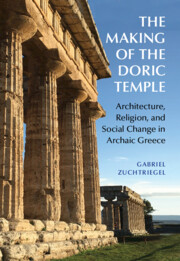-
Select format
-
- Publisher:
- Cambridge University Press
- Publication date:
- 22 July 2023
- 20 April 2023
- ISBN:
- 9781009260114
- 9781009260107
- Dimensions:
- (254 x 177 mm)
- Weight & Pages:
- 0.7kg, 276 Pages
- Dimensions:
- Weight & Pages:
You may already have access via personal or institutional login
Book description
In this volume, Gabriel Zuchtriegel revisits the idea of Doric architecture as the paradigm of architectural and artistic evolutionism. Bringing together old and new archaeological data, some for the first time, he posits that Doric architecture has little to do with a wood-to-stone evolution. Rather, he argues, it originated in tandem with a disruptive shift in urbanism, land use, and colonization in Archaic Greece. Zuchtriegel presents momentous architectural change as part of a broader transformation that involved religion, politics, economics, and philosophy. As Greek elites colonized, explored, and mapped the Mediterranean, they sought a new home for the gods in the changing landscapes of the sixth-century BC Greek world. Doric architecture provided an answer to this challenge, as becomes evident from parallel developments in architecture, art, land division, urban planning, athletics, warfare, and cosmology. Building on recent developments in geography, gender, and postcolonial studies, this volume offers a radically new interpretation of architecture and society in Archaic Greece.
Awards
Winner, 2024 Choice Awards
Reviews
‘This excellent, thought-provoking book is very different from the many traditional books about Greek architecture that focus on the Doric style and its evolution in purely architectural terms. … The author provides interesting discussion of how and why the Doric temple, set within a sanctuary, came to define religious space and at the same time shift the focus from traditional religious beliefs in gods as spiritual forces that dwelled in various environments in nature to anthropomorphic temple cult images in urban contexts. Well written and rich in ideas and approaches, this is a book for scholars. … Essential.’
J. Pollini Source: Choice
Contents
Metrics
Altmetric attention score
Full text views
Full text views help Loading metrics...
Loading metrics...
* Views captured on Cambridge Core between #date#. This data will be updated every 24 hours.
Usage data cannot currently be displayed.
Accessibility standard: Unknown
Why this information is here
This section outlines the accessibility features of this content - including support for screen readers, full keyboard navigation and high-contrast display options. This may not be relevant for you.
Accessibility Information
Accessibility compliance for the PDF of this book is currently unknown and may be updated in the future.



